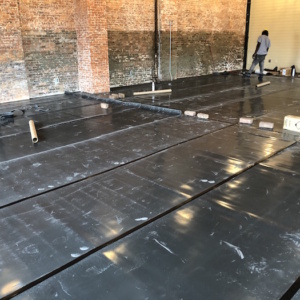

You can then increase this rating through various other methods, including adding another layer of drywall or simply using MLV on both sides of the wall. The STC ratings use a logarithmic formula, which would mean that adding a 1 LB MLV with a 26 STC to a wall with a 33 STC would result in around a 41-42 STC. Just because you add, for example, a 1LB MLV to a wall does not mean you get to add together the STC ratings. This is where the STC rating can confuse some people. A standard wall assembly made of 5/8” drywall with standard 2”x4” studs has an STC rating of 33.

Another important thing to note is that every partition has an STC rating, that provides some level of sound reduction. What it can do is assure you of this scientific fact: the higher the STC rating, the more sound is stopped. The STC only tests frequencies between 1Hz, so it cannot give you test data for extremely low or extremely high frequencies. A curve is created using this test to determine the transmission loss at those 18 common points. STC works by averaging the amount of noise stopped at 18 different common frequencies, measured in decibels. Transmission Loss measures how much sound is blocked by a partition. Frequency (measured in hertz (Hz) determines the pitch of a sound. To simply: Decibels (dB) measures how loud a sound is. Therefore, there is a transmission loss of 25 dB. The dB in Room A could be 100 dB, and only 75 dB in Room B. An example would be if you were playing a drum set in room A, and there was a wall dividing you from room B. Transmission Loss is the measurement of decibel difference on either side of a wall. The third term to know is Transmission Loss. High pitch sounds include such things as whistles or cymbals. Low pitch sounds include things like the lowest pedal on a pipe organ, bass drums, and large truck engines. The standard human range for hearing is between 20 and 20,000 Hz.

Frequency is the property of sound that determines pitch, such as the difference in a high pitch or a low pitch sound. The second is frequency, measured in hertz (Hz). 0 dB is near-total silence, while sounds over 85 dB can cause hearing damage or loss. The decibel is figured by determining how loud a sound is, in relation to how far away from your testing area it is. The decibel, or dB, is universally used to measure the intensity of a sound. There are three main terms to understand when understanding STC.

Simply put, this means that STC measures how much sound is lost when traveling from one side of a wall, floor, or ceiling, to the other side. STC is an integer rating of how well building partitions reduce airborne sound. It is one of the original ways to determine how much sound materials block, and is still considered to be one of the best ways to determine sound transmission loss. Sound Transmission Class, or STC, was first used in 1961.


 0 kommentar(er)
0 kommentar(er)
